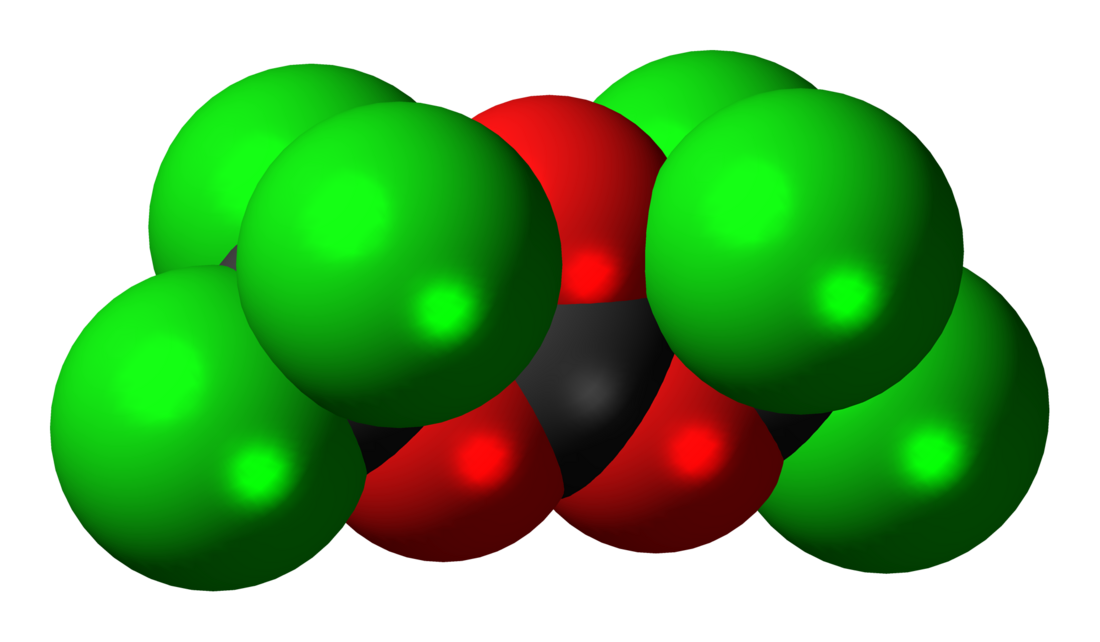Triphosgene
Chemical compound From Wikipedia, the free encyclopedia
Triphosgene (bis(trichloromethyl) carbonate (BTC)) is a chemical compound with the formula OC(OCCl3)2. It is used as a solid substitute for phosgene, which is a gas and diphosgene, which is a liquid.[5][6] Triphosgene is stable up to 200 °C.[7] Triphosgene is used in a variety of halogenation reactions.[8]
 | |
 | |
| Names | |
|---|---|
| Preferred IUPAC name
Bis(trichloromethyl) carbonate | |
| Other names
BTC | |
| Identifiers | |
3D model (JSmol) |
|
| ChemSpider | |
| ECHA InfoCard | 100.046.336 |
PubChem CID |
|
| UNII | |
CompTox Dashboard (EPA) |
|
| |
| |
| Properties | |
| C3Cl6O3 | |
| Molar mass | 296.748 g/mol |
| Appearance | white solid |
| Density | 1.780 g/cm3 |
| Melting point | 80 °C (176 °F; 353 K) |
| Boiling point | 206 °C (403 °F; 479 K) |
| Reacts | |
| Solubility | *soluble in dichloromethane[1] |
| Hazards | |
| GHS labelling: | |
  [4] [4] | |
| Danger | |
| H314, H330[4] | |
| P260, P280, P284, P305+P351+P338, P310[4] | |
| Safety data sheet (SDS) | SDS Triphosgene |
Except where otherwise noted, data are given for materials in their standard state (at 25 °C [77 °F], 100 kPa).
| |
Preparation
This compound is commercially available. It is prepared by exhaustive free radical chlorination of dimethyl carbonate:[6]
- CH3OCO2CH3 + 6 Cl2 → CCl3OCO2CCl3 + 6 HCl
Triphosgene can be easily recrystallized from hot hexanes.
Uses
Triphosgene is used as a reagent in organic synthesis as a source of CO2+. It behaves like phosgene, to which it cracks thermally:
- OC(OCCl3)2 ⇌ 3 OCCl2
Alcohols are converted to carbonates. Primary and secondary amines are converted to ureas and isocyanates.[6][7][9][10]
Triphosgene has been used to synthesize chlorides.[8] Some Alkyl chlorides are prepared by treating alcohols with a mixture of triphosgene and pyridine. Alkyl dichlorides and trichlorides can similarly be synthesized using triphosgene. Vinyl chlorides are synthesized from ketones using triphosgene and DMF to form a Vilsmeier reagent, followed by a ring opening by chloride ions. Aryl chlorides can also be produced using a Vilsmeier reagent from triphosgene and DMF.
Safety
The vapor pressure of Triphosgene is sufficiently high for it to reach concentrations that are considered toxicologically unsafe.[11] While several properties of triphosgene are not yet readily available, it is known that it is very toxic if inhaled. A toxic gas is emitted if it comes in contact with water.[12] There is a lack of information and variability regarding the proper handling of triphosgene. It is assumed to have the same risks as phosgene.[13][14]
See also
References
External links
Wikiwand - on
Seamless Wikipedia browsing. On steroids.
